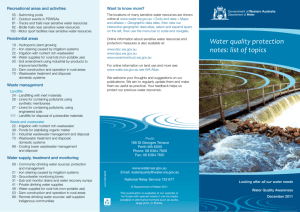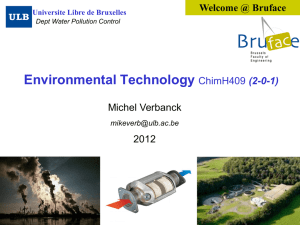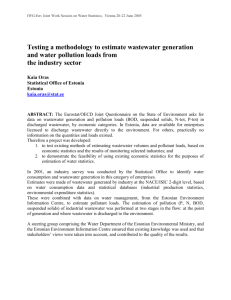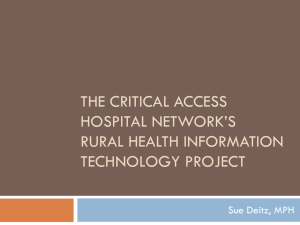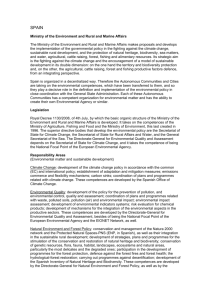Summary of Innovative Practices in JAPAN
advertisement
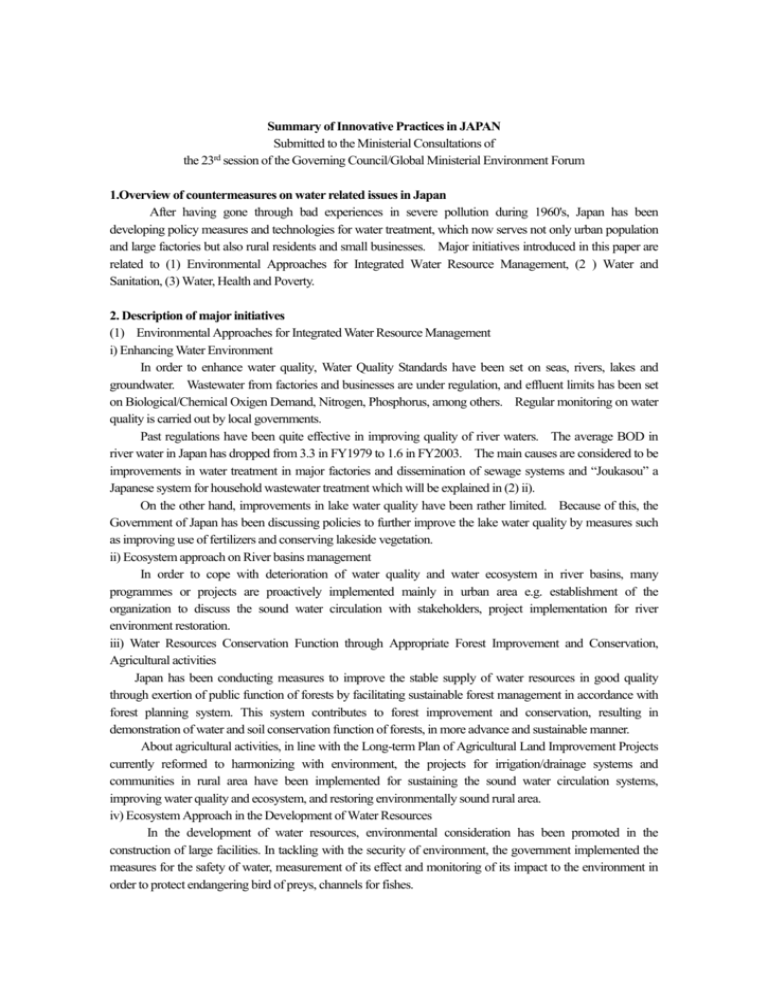
Summary of Innovative Practices in JAPAN Submitted to the Ministerial Consultations of the 23rd session of the Governing Council/Global Ministerial Environment Forum 1.Overview of countermeasures on water related issues in Japan After having gone through bad experiences in severe pollution during 1960's, Japan has been developing policy measures and technologies for water treatment, which now serves not only urban population and large factories but also rural residents and small businesses. Major initiatives introduced in this paper are related to (1) Environmental Approaches for Integrated Water Resource Management, (2 ) Water and Sanitation, (3) Water, Health and Poverty. 2. Description of major initiatives (1) Environmental Approaches for Integrated Water Resource Management i) Enhancing Water Environment In order to enhance water quality, Water Quality Standards have been set on seas, rivers, lakes and groundwater. Wastewater from factories and businesses are under regulation, and effluent limits has been set on Biological/Chemical Oxigen Demand, Nitrogen, Phosphorus, among others. Regular monitoring on water quality is carried out by local governments. Past regulations have been quite effective in improving quality of river waters. The average BOD in river water in Japan has dropped from 3.3 in FY1979 to 1.6 in FY2003. The main causes are considered to be improvements in water treatment in major factories and dissemination of sewage systems and “Joukasou” a Japanese system for household wastewater treatment which will be explained in (2) ii). On the other hand, improvements in lake water quality have been rather limited. Because of this, the Government of Japan has been discussing policies to further improve the lake water quality by measures such as improving use of fertilizers and conserving lakeside vegetation. ii) Ecosystem approach on River basins management In order to cope with deterioration of water quality and water ecosystem in river basins, many programmes or projects are proactively implemented mainly in urban area e.g. establishment of the organization to discuss the sound water circulation with stakeholders, project implementation for river environment restoration. iii) Water Resources Conservation Function through Appropriate Forest Improvement and Conservation, Agricultural activities Japan has been conducting measures to improve the stable supply of water resources in good quality through exertion of public function of forests by facilitating sustainable forest management in accordance with forest planning system. This system contributes to forest improvement and conservation, resulting in demonstration of water and soil conservation function of forests, in more advance and sustainable manner. About agricultural activities, in line with the Long-term Plan of Agricultural Land Improvement Projects currently reformed to harmonizing with environment, the projects for irrigation/drainage systems and communities in rural area have been implemented for sustaining the sound water circulation systems, improving water quality and ecosystem, and restoring environmentally sound rural area. iv) Ecosystem Approach in the Development of Water Resources In the development of water resources, environmental consideration has been promoted in the construction of large facilities. In tackling with the security of environment, the government implemented the measures for the safety of water, measurement of its effect and monitoring of its impact to the environment in order to protect endangering bird of preys, channels for fishes. (2) Water and sanitation; i) Mechanism for Sustainable Development of Water Resources In the Beginning of the 1960’s, in order to cope with the rapid increase of demand for water, the Japanese Government has framed new financial measures and organizations to conduct efficient development of water resources. ii) Wastewater Treatment Through construction of sewerage systems, the percentage of sewered population achieved 66.7% in fiscal 2003, and water environment is improved in many rivers, lakes and marshes, and oceans. The Ministry of Land, Infrastructure and Transport promoted advanced wastewater treatment on the basis of basin-wide programmes. Moreover, in F.Y.2001, 190 million ㎥ of treated wastewater were used for flush toilets and environmental use as a precious water resource in urban areas. “Joukasou” is a system developed in Japan for on-site treatment of wastewater from households. It is popular in communities located in areas in which population density is not high enough for building sewage systems very economically. Such a system has been built as a cost-effective measure easy to be built within a relatively short period of time in a small area of land for each household. It now treats wastewater from more than ten million people in Japan. It started as a system which reduces BOD, and then technologies have been developed for treatments also for Nitrogen and Phosphorus. Government subsidies for disseminating “Joukasou” were introduced in FY1987, which was later than those for sewage systems. In FY2005, such subsidies are planned to be merged with other subsidies, so that local governments can choose the most cost-effective wastewater treatment for their residents. In order to improve water quality in agricultural use and contribute to the improvement of rural environment by promoting the treatment of domestic sewerage in rural communities, including recycling of resources and waste in agriculture, the national subsidy program for Rural Community Sewerage Improvement Projects was inaugurated in 1983. iii) Establishment of Sound Hydrological Cycles System Rapid economic growth and progress of urbanization have resulted in many water-related problems, such as deceasing ordinary discharge, water pollution and drawdown of groundwater level. In order to solve these problems and promote the establishment of sound hydrological cycles system, the Japanese Government set up the liaison meetings among all the water related ministries/agencies. Also, joint activities by various stakeholders, including central/local governmental agencies, water users, private companies and citizens have been implemented in each river basin. (3) Water, health and poverty ; A method of developing small scale rural water supply systems for drinking water In establishing rural water supply systems, a series of campaigns started to promote the collaboration between the local governments and communities, especially at an early stage. As a result, water supply systems have rapidly spread in rural area and consequently they ensured safe drinking water for people in rural villages. The systems significantly reduced the number of patients of waterborne infectious diseases and made women and children free from tasks of drawing and carrying water. To cover the cost of water supply systems, the government encouraged people voluntarily participate in the development of water supply systems with the ownership spirit. (4) Others – Research and Development Energy-efficient reverse osmosis seawater desalination technology has now been developed and as a result of efforts to reduce the overall costs involved this technology is now being commercialized as an effective way of dealing with water shortages. Various Earth observations are performed throughout the world including our country, and important data is offered. Establishment of the Global Earth Observation System of Systems (GEOSS) that gazes at 10 years onwards is aimed by making these existing systems coordinate and expand with mutual cooperation, on the grounds of decision of the implementation plan adopted at the third Earth Observation Summit in February 2005. The Council for Science and Technology Policy promotes research cooperation among ministries and agencies by advocating research initiatives related to water issues e.g. Eco-Harmonics River Basin and Urban Area Regeneration Research Initiative and Global Water Cycle Research Initiative. 3. Mainstreaming / Sustainability These initiatives are stated in the Environment Basic Plan, Japanese NSDS, and other related strategies or national plans. 4. Replicating the Initiatives The experience for the water environment management in Japan are applicable to other countries, so that Japanese government has taken the effort to disseminate the experiences through various programmes e.g. joint research, exchange of specialists, acceptance of trainees, loan and grant assistance. (1) The Portfolio of Water Actions (PWA) was announced at the Ministerial Conference on 3rd World Water Forum and Japan has been encouraging to make use of the PWA website network with international organizations. Japan intends to introduce its 91 concrete actions to other countries through the network. As one of the PWA, the Ministry of the Environment of Japan proposed “Water Environment Partnership in Asia (WEPA)” at the Third World Water Forum as a new initiative in developing a platform for strengthening water governance and capacity building to solve water environmental problems in the region. The main activities of WEPA are development of databases that will serve as a common information platform on water environment. The databases will be made public through Internet among the relevant stakeholders including government officials and NGOs as a common asset. (2) Network of Asian River Basin Organizations (NARBO) was established February 2004 to share respective counties’ experiences and information among governments, river basin organizations and related organizations. “The International Network for Water and Ecosystem in Paddy Fields (INWEPF)” was established in November 2004. The network provides an open platform for promoting dialogue, strengthening capacity building, developing good practices and formulating ideas for innovative policy on sustainable water use, environmental conservation and better governance in rice-based systems. “Water and Forest International Network” was established in August 2004 to share awareness and to develop research on water and forest through exchange of opinion and information.




